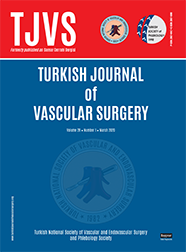
The Turkish Journal of Vascular Surgery
Yazarlar: Serkan Burç Deşer
Konular:-
Anahtar Kelimeler:Carotid endarterectomy,Near-infrared spectroscopy,Stump pressure
Özet: Objectives: In this study, we aimed to evaluate and compare the cerebral oximetry monitoring with near-infrared spectroscopy and the mean stump pressure measurement for the decision of shunting after carotid artery cross-clamping during carotid endarterectomy. Patients and methods: Between January 2015 and October 2017, a total of 42 patients (33 males, 9 females; mean age 71.3±8.5 years; range, 56 to 92 years) who underwent carotid endarterectomy were retrospectively analyzed. The patients were divided into shunting/non-shunting groups and patients with postoperative major neurological complications/without complications groups. Results: Carotid artery cross-clamping caused a significant decrease in regional cerebral oxygen saturation (rSO2) in the shunting group (p=0.01), while the contralateral remained stable (p=0.121). The mean ipsilateral rSO2 reduction was 35% in the shunting group and only 6.6% in the non-shunting group (p=0.019). Postoperative hemiplegia developed in three (7.1%) patients in the shunting group whose ipsilateral rSO2 was not reduced during cross-clamping, despite the mean stump pressure was reduced (p=0.03). Conclusion: Our study results show that near-infrared spectroscopy can demonstrate much more precise results than stump pressure measurement in predicting the need for shunting to prevent perioperative major neurological complications after carotid cross-clamping during carotid endarterectomy.